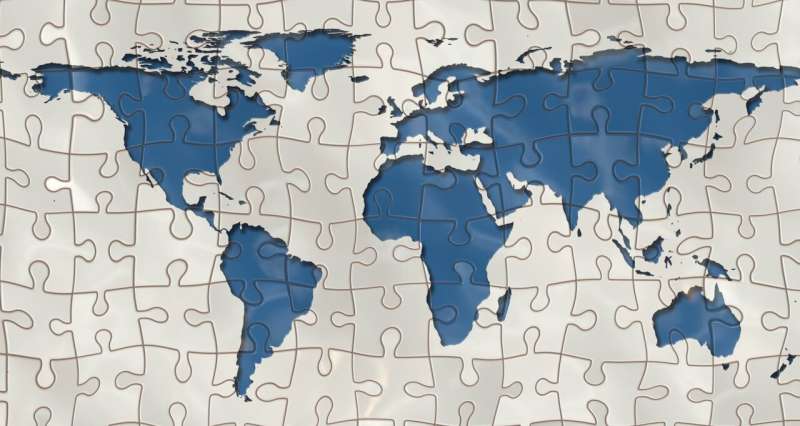
A completed puzzle tells a story more effectively than any individual piece could on its own, but every piece is necessary to complete the image. That’s an analogy for how the Global Nutrition and Health Atlas—a public resource with diet-related health information for more than 190 countries spanning across 30 years—works. The GNHA has thousands of contributors, and when more pieces are added, the picture becomes clearer.
Powered by researchers at the Friedman School of Nutrition Science and Policy at Tufts and Nestlé Research, the GNHA houses large amounts of data that researchers, students, practitioners, and health policymakers can use in their work.
“When researchers and policymakers have access to a fuller picture of dietary patterns, gaps in nutrient intake, environmental impact, eating habits and nutritional requirements for children and infants,” says Elena Naumova, chair of the Division of Nutrition Epidemiology and Data Science at the Friedman School, “they have a better idea of what and where resources need to be deployed to promote healthy nutrition.”
The GNHA was created to foster cross-collaboration in developing a more complete response to pressing global nutrition challenges, such as access to nutritious and affordable foods, nutrition education, and sustainable food systems.
Its data and visualizations can be used to design tailored, evidence-based interventions and inform policy changes or resource distribution. Ultimately, these combined efforts at individual, community, and policy levels can have a positive ripple effect on the nutrition and health statuses of people throughout the world, says Naumova.
Tufts Now spoke with Naumova to learn more about the Atlas’s genesis, gaps in data, and the database’s role in future nutrition research.
Tufts Now: What prompted the creation of the Global Nutrition and Health Atlas?
Elena Naumova: We wanted the GNHA to be both a tool of research and public service empowerment. Vast data sets are available online, however, they can be hard to find or difficult to understand. To address those challenges, we created one location that contains pertinent health data and allows for it to be presented in a visually interesting way.
The site is a repository for over 1,000 metrics belonging to six dimensions: demographics, dietary intake, nutritional status, health status, health economics, and food sustainability. The data included is wide-ranging, highly detailed, validated, and publicly available. Not only is it important to provide high quality data, but also to give tools for proper analysis and application.
To empower the public, the platform offers training and case studies for data usage. Our hope is that by promoting data access and training, there is greater room for cross-collaboration and innovative interdisciplinary research opportunities among a variety of users.
Gathering this data in one place can help us overcome some of the challenges in making informed recommendations for healthy diets and nutrition. When researchers and policymakers have access to a fuller picture of dietary patterns, gaps in nutrient intake, environmental impact, eating habits and nutritional requirements for children and infants, and the number of health care facilities in a region, for example, they have a better idea of what and where resources need to be deployed to promote healthy nutrition.
Where does the data come from?
Our focus is to draw data from reputable sources that are tested by time and its users. The GNHA curates data from more than 15 public databases, such as the World Bank, World Health Organization, United Nations, and Dietary Household Survey, and internal sources like Nestlé, the Global Dietary Database, and the Global Burden of Disease.
The data can be accessed either as collective metadata or by specific indicators, timespan, and country/ region of interest. As a global database, this is a place to obtain nutrition and health information, as well as deposit your own data.
Missing data is a problem that typically accompanies large data sets. How does the Atlas confront this issue?
Missing data is a serious problem no matter how large the data set. Because it’s a common issue, we are committed to transparency and data quality assurance. Data only comes from established and credible public sources, and it’s reviewed prior to being added to the platform. All data is accompanied by well-documented metadata that contains information on how much of it is missing, a glossary of terms and their definitions, and links to the original source.
We also must keep in mind that occasionally with large, global data sets, some voices get lost in the conversation. In some countries, data collection is challenging because of resource limitations, cost, and maintenance considerations. If missing data cannot be addressed, it’s essential at a minimum to raise awareness about the issue and maintain transparency and parity.
How do you envision this tool improving nutrition research and, potentially, some of the six dimensions tracked in the GHNA, such as nutritional status or food sustainability?
Data from the GNHA can evaluate as well as compare indicators at country, region, and global levels, either to each other or over time. Studying these relationships can tell us as researchers what indicators have improved and where future interventions may need to be targeted.
A major component of improving nutrition research is education, and the platform’s educational benefits are two-fold. First, it offers the next wave of researchers, students, and policymakers an opportunity to learn from data visualization. Graphic or pictorial representations can simplify complex data sets and convey information in a quick, efficient manner. That can prompt stronger and more effective interdisciplinary approaches to time-sensitive concerns such as malnutrition, diet-related diseases, and maternal health.
Moreover, visualizations can reveal patterns or trends that otherwise couldn’t be captured. Many of us are visual learners and seeing data through a colorful display can make it more comprehensible. From a policy and intervention perspective, it allows for understanding of what researchers and policymakers have been doing right, and where we need to improve.
Source: Read Full Article
